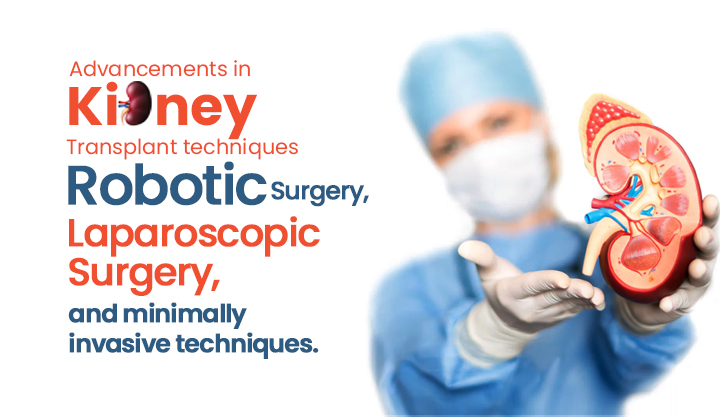
Advancements in Kidney Transplant techniques: Robotic Surgery, Laparoscopic Surgery, and minimally invasive techniques
Our bodies are miracle-makers. They keep taking care of us in an uncountable number of ways, working continuously at keeping us not just alive but enjoying our lives normally. It is only when an organ starts malfunctioning that we realise what it did for us in the normal course of our day. Take, for example, our kidneys. They are responsible for ridding our body of toxins, balancing our bodily fluids, regulating our blood pressure, producing the Vitamin D needed by our bones to stay strong, controlling the red blood cells produced by our bodies, and so much more. Hence, it is not surprising that we are incapacitated when one or both stop functioning, and we cannot ignore it and will need to intercept ideas before the body reaches the stage of end-stage renal disease or kidney failure. End-stage renal disease happens when the kidneys no longer work enough to keep the body running on its own, and one will have to resort to life-long dialysis, conservative care, or a kidney transplant in order to stay alive.
What Exactly Is a Kidney Transplant All About?
Organ transplantation is one of the greatest advancements in medical science. It literally gives recipients a new lease of life. Organ transplantation is done for major organs like liver, kidney, pancreas, heart, lungs, Intestine, cornea, bone marrow, etc. The transplant surgery involved is literally life-saving, and is one of the best ways yet available to us in the field of medicine. It, needless to say, requires extreme skill and know-how. It is the most challenging and most complex of all surgeries. A Kidney Transplant surgery involves taking a functional Kidney from a donor, dead or alive, and replacing the recipient’s damaged kidney with it. The surgical procedure is chosen carefully from among a set of minimally invasive techniques available in modern medicine. The benefits of Robotic Surgery are many. For example, the incision made can be smaller than is normally required, the depth of the incision will not matter, the sutures can be finer, chances of infection will be less, pain will be less, blood loss will be less, duration of hospital stay will be reduced, recovery time will be sooner, the surgical scar will be minimal and so on. Some of the minimally invasive techniques used in kidney transplant surgery are robotic surgery and laparoscopic surgery.
How Laparoscopic Surgery Is Conducted
Laparoscopic surgery is conducted by inserting a thin long tube into the area to be operated upon. A camera fitted to it gives the surgeon a view of the procedure. He or she conducts it through another small incision.
Robotic Surgery and Its Benefits
Robotic surgery, also known as Robot Assisted Kidney Transplantation (RAKT), is a minimally invasive surgical procedure where the transplant surgeons, who have had extensive training and experience in robotics, perform the transplant with the help of robots. The surgeon uses the precise and controlled, tremor-free hand movements of the robot instead of his or her own to perform the transplant. This helps him or her concentrate on the correctness of the procedure rather than the minute yet crucial details of the intricacies of performing it.
The Importance of Post-operative Care
The period of post-operative care following a Kidney Transplant is as important as the actual surgery itself. The success of the surgery, along with the extent and rate of recovery, depends a lot on this period too. It will involve spending enough time at the hospital on temporary dialysis while the surgical wound heals and the new kidney starts functioning properly, the regularity of routine follow-ups with the transplant team, the regular continuation of immunosuppression or anti-rejection medication for the rest of one’s life, and more.
A special note on immunosuppression won’t be out of place here. It refers to one of the most important parts of the kidney transplant process, both during and after the actual surgery. It involves the use of relevant anti-rejection drugs that help the body accept its new kidney and allow it to continue functioning properly. It should be taken as prescribed, with no misses, for the rest of one’s life in order to live to the best of his or her potential.
